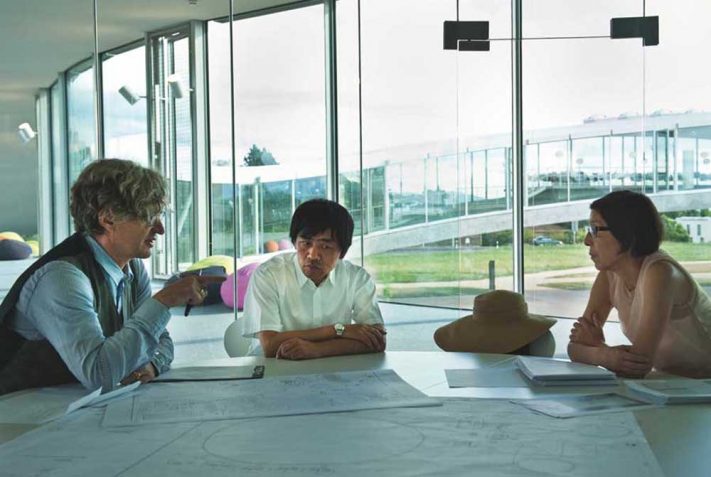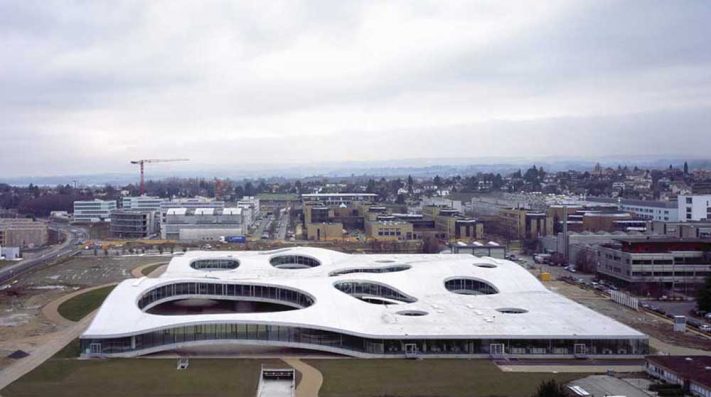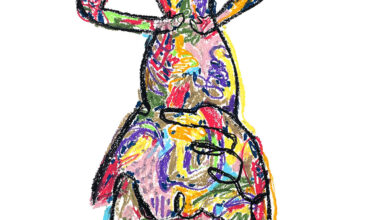Director Wim Wenders previewed in Venice his latest film project, an installation in collaboration
with Japanese architectural firm SANAA.
By Anna Battista
Film enthusiasts may be gathered on the Lido to follow the Venice Film Festival, but, this year, cinema fans will be able to indulge their passion also at the 12th International Architecture Exhibition (www.labiennale.org/en/architecture). One of the first things visitors to the Arsenale spaces will be provided with is indeed a pair of special glasses to watch Wim Wenders’ s 3D film for SANAA, the Japanese architectural firm established in 1995 by Kazuyo Sejima and Ryue Nishizawa. Entitled “ If Buildings Could Talk…” and screened in a continuous loop, the film is based around SANAA’ s Rolex Learning Center on the EPFL (Ecole Polytechnique Fédérale Lausanne) Campus, one of the most famous Swiss universities, in Lausanne. Though very futuristic and characterised by a sort of waving shape, the building – that includes spaces open to the public such as a café, a restaurant, a library and an exhibition space – is perfectly integrated with the lake and the mountains surrounding it. Yet “ If Buildings Could Talk…” is much more than a film about a building: Wenders tried to get lost inside the centre and let it speak for itself, creating a short narrative piece, recording images from the life of the building from morning till night, showing people meeting in the café or jogging around the place, students reading in the library or working on their laptops. Even the architects get a cameo role: Wenders filmed them driving two segways around the multi-functional open spaces around the campus. The film is poetical, well shot and accompanied by a very moving soundtrack and a monologue read by the building itself that explains she learnt to speak from the books in the library. The installation, aimed at creating a dialogue with the viewers and at turning the building into an abstract entity that haunts its visitors, is conceived as a visual investigation in response to the theme of the Biennale 2010, “ People Meet in Architecture“.
Zoot Magazine: How did the project come together?
Wim Wenders: A few months ago I got this incredible invitation from SANAA to consider developing an installation or making a film about this unbelievable building. As a photographer and filmmaker I very much work from a sense of place and my theory about places is that they have stories to tell. If you are in a place for a while and if you are able to listen, you will hear the place’ s story. I get all my inspirations from landscapes, cities, deserts and buildings, so the invitation to make a film about the Rolex Center almost sounded too good to be true.
Zoot Magazine: Why did you decide to shoot it using 3D technology?
Wim Wenders: When I started thinking about how I could make a film in this fantastic location, I realised it was impossible doing it without focusing on the dimension of space. If any building explores space it’ s indeed the Rolex Centre and so I decided to film the installation in 3D. My stereographer, Alain Derobe, a pioneer in the field, built a steady cam and a device to make a film with two very light photo cameras shooting in HD. We shot for several days with a small and flexible crew and moved through the building, up and down, underneath and above. I did see the film in 2D because we edited it in 2D and it was like something exceptional was being taken away from us because, in this format, it’ s very hard to feel the space and get the idea that this building has waves, hills and slopes. Whereas by using 3D technology, the viewers really feel as if they are walking inside the building.
Zoot Magazine: Did the shots of Berlin’s Staatsbibliothek in “Wings of Desire” inspire you the library
shots in “I f Buildings Could Talk…”?
Wim Wenders: As someone who likes reading, libraries are some of the most gentle and peaceful places on this planet and I loved the way the library in SANAA’ s project is considered as its heart since it’ s located at the highest point of the building. It was a pleasure to shoot in the Staatsbibliothek in Berlin because it is also a building made for the pleasure of reading. The few days we shot there “ Wings of Desire” turned into the most spiritual experience of the entire film, because the place was like a cathedral dedicated to books and reading. Filming in SANAA’ s building reminded me a lot of that, but I also felt that, what we had tried then with heavy technology and cranes, had finally become easier, lighter and freer. Looking back at that shoot in Berlin, it felt like it had happened a long time ago, but, at the time, the cameras and not the building represented for us an obstacle, while filming in the Rolex Center was liberating, we almost felt we belonged there.
Zoot Magazine: Why did you decide to include a monologue in the film?
Wim Wenders: I didn’ t want to make a film that felt like a documentary, but I wanted to turn architecture into the main protagonist of the film. When working on it I remembered my final theory that places talk to us and that, with a little bit of patience, we can listen to the stories they have to tell us. I realised that, if I took my own theory seriously, this building could have talked to us all. It seemed like an absurd idea, but the more I thought about it, the more I liked it and, in the end, my theory became the project’ s title.
Zoot Magazine: What’s the role of Thom Hanreich’s music in the film?
Wim Wenders: It would have been difficult to communicate to the audience only through the building’ s voice. Music is very important since it is meant to transport you somewhere else and, in this case, it has a sort of unifying role, supporting the 3D experience and allowing the viewer to literally fly around the building.
Zoot Magazine: What was the most exciting thing about shooting in this building?
Wim Wenders: I have never seen any building in the world that resembles more a landscape than this one. If I had to describe this building I’ d say it’ s more landscape than building, with valleys, hills and lakes. The Rolex Center has got great purity and offers an immense richness of inspirations with all its unbelievable angles and the fact that it has only one floor and that the floor lifts creating spaces underneath is simply amazing. The more I spent in the building, the more I wanted to keep filming it and, as my camera team can confirm, it was hard to pull me out of it, in fact I could still be shooting in there as I feel there are angles we didn’ t manage to capture and, even now, I’ m not able to say if I like the building better from underneath or inside.
Zoot Magazine: What fascinates you the most about the Rolex Center?
Wim Wenders: While filming the building I felt it had something that it was absolutely Japanese, though it was hard to point out what it was. Maybe it’ s the utter simplicity it has that leads at the same time to the greatest complexity. The Rolex Center has just one floor, but that floor goes up and down and allows you to walk under it. Normally, you walk under a building if it’ s on sticks, but here the building goes into the ground and then it goes up again and the way you walk under it is almost as mysterious as the way you walk inside it. Maybe this great simplicity mixed to an incredible complexity is what makes the building Japanese in its essence. In a way, it’ s the same feeling you get with Japanese fashion: don’ t ask me why, but I can recognise a suit from Yohji Yamamoto from one hundred yards thanks to its perfect mix of reduction and finesse.
The 12th International Architecture Exhibition, Venice, Italy, runs until 21 November 2010.
Photography by Hisao Suzuki and Donata Wenders








